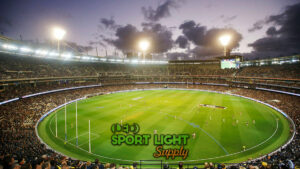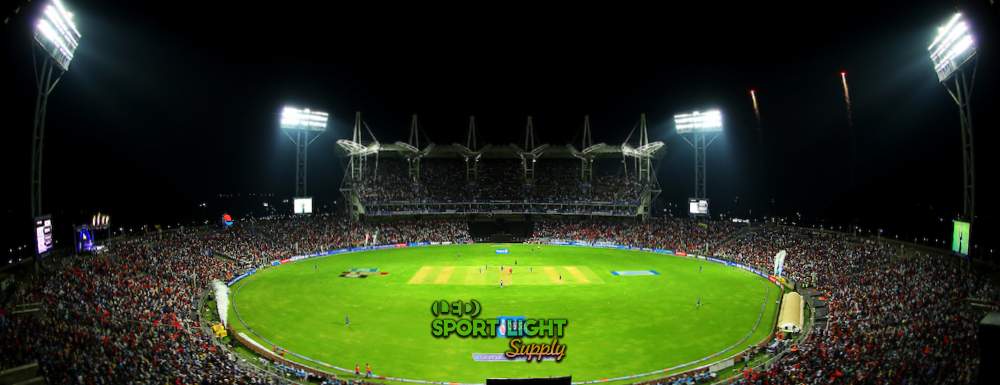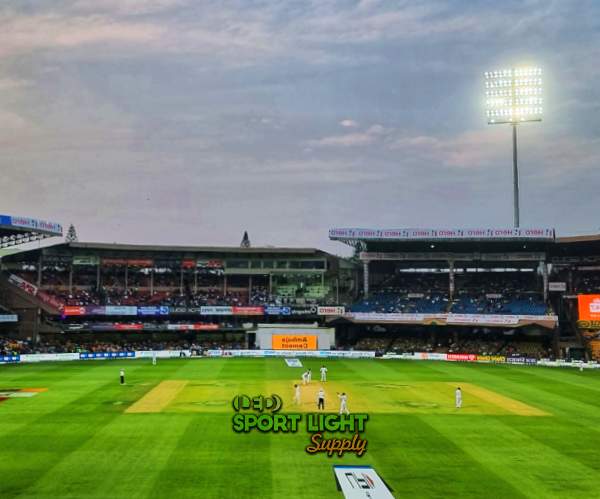
Creating an optimal environment for cricket matches, especially for high-stakes international games, requires a careful consideration of lighting standards. Lighting quality affects visibility, gameplay, and even the viewing experience of spectators, making well-designed lighting setups vital for both players and fans. As cricket continues to thrive in countries worldwide, evening games have become more common, increasing the need for effective lighting on the field. International lighting standards ensure that players can see the ball clearly under various conditions, reducing the likelihood of errors and promoting fair play.
Table of Contents
Toggle| Parameter | Standard Requirement | Notes |
|---|---|---|
| Illumination Level (Lux) | Minimum 1500 lux | For domestic and standard games; provides adequate visibility for evening and night matches. |
| 2000 lux or more | Required for international matches and televised events to ensure top visibility and clarity. | |
| Uniformity Ratio | Minimum 0.7 | Ensures consistent lighting across the field, reducing bright and dark spots. |
| Glare Control | Advanced optics with low glare | Minimizes interference for players and enhances visibility for spectators and broadcasts. |
| Pole Height | 20 to 30 meters | Ensures broad light coverage across the field; height depends on field size and lighting needs. |
| Pole Placement | Around field perimeter | Positioned to eliminate shadows and focus light on the playing area. |
| Energy Efficiency | High efficiency (LED) | LEDs convert more energy into light, reducing operational costs and environmental impact. |
| Lifespan | Up to 150,000 hours | Long lifespan reduces maintenance and replacement costs. |
| Smart Lighting Options | Remote control and customization | Allows for adjustments in brightness, color temperature, and timing based on real-time needs. |

The standard level of illumination for cricket fields is governed by international guidelines designed to maintain visibility and fairness. A minimum lux level of 1500 at the playing surface is the baseline for cricket fields, allowing players to see the ball, field, and each other with clarity. This standard illuminance is particularly crucial for evening matches and when weather conditions reduce natural light. Venues hosting international matches may require even higher illumination, with levels reaching up to 2000 lux. This increase in lighting intensity creates an environment where visibility remains consistent, ensuring fair play across all areas of the field.
Proper lighting not only supports visibility but also influences gameplay. Cricket is a fast-paced sport where a fraction of a second can determine the outcome of a play. Adequate lighting enables players to track the ball in motion, enhancing response times and reducing the likelihood of errors due to poor visibility. Spectators, both at the venue and watching from home, benefit from the improved viewing experience that quality lighting provides. Bright and well-distributed lighting ensures that the game is enjoyable for everyone involved, supporting both accuracy in play and engagement for viewers.
Lighting standards play a significant role in promoting fair play by eliminating visibility advantages. Uniform lighting prevents any player from experiencing an area with less visibility, reducing unfair conditions that might influence performance. A well-lit field ensures that all players have equal conditions, which is especially crucial in cricket where even slight visual impairment can impact reaction time, hand-eye coordination, and fielding accuracy. These standards help in maintaining an even playing field for teams, making the lighting configuration a core component of fair play regulations.
LED technology has transformed the lighting industry, especially in high-demand environments such as sports fields. LEDs are highly efficient, converting most of the energy they consume into light rather than heat. This efficiency leads to significant energy savings compared to traditional lighting options. For cricket fields that require high levels of illumination, LED lighting systems reduce the overall energy consumption while maintaining the required brightness. The energy efficiency of LEDs not only lowers operational costs but also contributes to a reduced environmental footprint.
One of the main advantages of LED lighting in sports applications is the cost-effectiveness it provides over time. Although LED systems can initially require a higher investment than traditional lighting systems, their lower energy usage leads to reduced electricity costs, which becomes evident in the long run. By converting a larger percentage of electricity into visible light, LEDs minimize waste, making them a financially sustainable choice for cricket field lighting. Additionally, LEDs often come with smart control options, allowing for dynamic adjustments based on usage needs, further reducing operational costs.
 LED lighting is known for its long lifespan, which often extends up to 150,000 hours or more with proper maintenance. This longevity allows cricket venues to minimize the frequency of light replacements, reducing interruptions to the game schedule and keeping the field consistently well-lit. The durability of LED lights also lowers maintenance costs, as they are less likely to experience the wear and tear associated with traditional lighting options. This extended life expectancy makes LEDs a reliable option for venues looking to maintain top-quality lighting without frequent disruptions.
LED lighting is known for its long lifespan, which often extends up to 150,000 hours or more with proper maintenance. This longevity allows cricket venues to minimize the frequency of light replacements, reducing interruptions to the game schedule and keeping the field consistently well-lit. The durability of LED lights also lowers maintenance costs, as they are less likely to experience the wear and tear associated with traditional lighting options. This extended life expectancy makes LEDs a reliable option for venues looking to maintain top-quality lighting without frequent disruptions.
Maintenance is a significant consideration for cricket field operators, as lighting failures can disrupt the flow of matches and impact visibility. LEDs, with their longer lifespan, reduce the need for regular replacements, translating to fewer maintenance-related interruptions. For large venues with extensive lighting systems, the ability to rely on LEDs for extended periods without compromising light quality streamlines maintenance routines and enhances operational efficiency. The robust design of LEDs also means they are less prone to failure under intense operating conditions, making them suitable for the demands of cricket field lighting.
The quality of illumination provided by LED lights is distinguished by their ability to deliver even light distribution across the playing surface. This evenness minimizes shadows and dark spots, allowing players to accurately judge the ball’s movement. With consistent lighting, players’ visibility remains constant no matter where they are positioned on the field, leading to smoother gameplay and reducing any advantage or disadvantage that uneven lighting might create. Even light distribution also benefits spectators, offering a clear and uninterrupted view of the entire field.
Glare can be a considerable issue on sports fields, where bright lights may obscure players’ vision and affect their performance. LED lighting systems incorporate advanced optics and glare control features to manage this issue, ensuring that both players and spectators have an unobstructed view of the game. By focusing the light directly onto the playing surface, these optics reduce the scattering of light, which helps in maintaining clarity. Reduced glare ensures that players can react quickly to on-field events, while fans enjoy a better viewing experience without harsh lighting interference.
The uniformity ratio is a critical aspect of cricket field lighting, representing the ratio between the minimum and average illuminance across the playing area. For cricket fields, a uniformity ratio of at least 0.7 is recommended to ensure consistent lighting conditions for players throughout the field. A high uniformity ratio eliminates bright and dim areas, enabling players to track the ball’s movement without adjusting to varying light levels. Consistent illumination supports fair gameplay, enhancing the players’ ability to focus solely on their performance rather than adapting to changing visibility.
Lighting consistency directly impacts player performance, as inconsistent light levels can disrupt a player’s visual perception. With a uniformity ratio of 0.7 or higher, players experience minimal variation in light intensity, allowing them to concentrate on the game without having to account for fluctuating brightness. This steadiness benefits fielders, batters, and bowlers, who can focus on their skills without adjusting to changes in light intensity. For spectators, uniform lighting provides a balanced visual experience, ensuring that every corner of the field is equally visible.
Modern LED lighting systems for cricket fields incorporate advanced optics to mitigate glare. These optics help channel light precisely onto the playing area, avoiding excessive brightness that could affect players’ sightlines. By directing the light more efficiently, LED systems reduce the risk of harsh reflections, creating a smoother lighting experience that supports optimal visibility. The optics in LEDs are engineered to offer high-performance lighting with minimal glare, making them ideal for cricket venues where visibility is paramount.
Controlled glare is equally advantageous for spectators, as it enhances their experience by providing a clear and comfortable view. For televised games, advanced glare control ensures that cameras capture the action without interference from bright spots or reflections. Clear broadcast visuals contribute to the overall appeal of the game, enhancing the experience for remote viewers. The integration of glare control in cricket field lighting benefits not only the players on the field but also those watching in stadiums or from home, contributing to a comprehensive viewing experience.
The placement of lighting poles is carefully considered to ensure optimal light distribution across the field. Poles are generally positioned around the perimeter, with specific arrangements that help achieve the required lux levels without creating dark spots or excessive light spillage. By strategically placing poles at intervals, lighting designers can focus the light directly onto the playing area, enhancing both the intensity and uniformity of illumination. Correct pole placement helps in maximizing visibility while minimizing the amount of light lost to areas outside the field.
The height of lighting poles, typically ranging from 20 to 30 meters, plays a crucial role in focusing the light onto the playing surface. Taller poles allow for a wider spread of light, covering larger areas while maintaining the desired lux levels. The height and angle of lights contribute to a more even illumination, reducing the chances of dark areas on the field. Additionally, high poles enable light to cover a broader surface area, creating a consistent brightness level across the entire field and ensuring that players have a clear view no matter where they are positioned.
Cricket field lighting standards contribute significantly to the quality of the sport, influencing player performance, audience experience, and the overall visibility needed for high-stakes matches. LED technology has revolutionized cricket field lighting by providing energy efficiency, long-lasting performance, and high-quality illumination that supports both fair play and a memorable viewing experience. As the demand for night games and televised broadcasts increases, lighting standards have adapted to meet these needs, focusing on high lux levels, uniformity ratios, glare control, and strategically placed lighting poles.
Drop us a line to receive a free lighting design